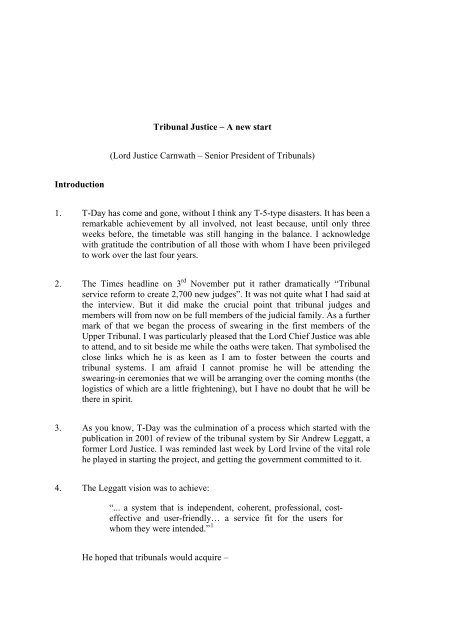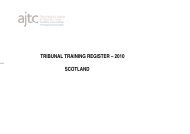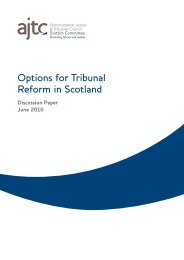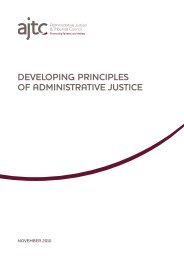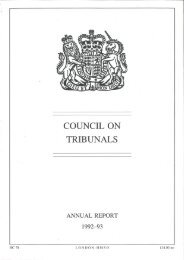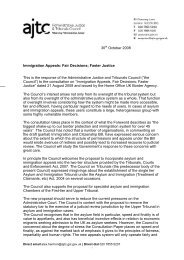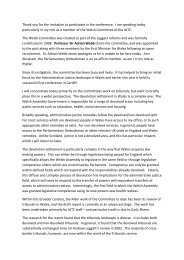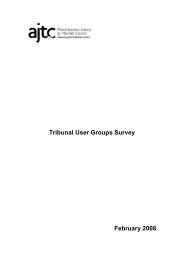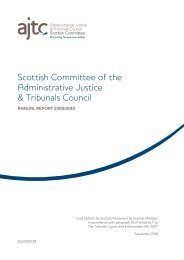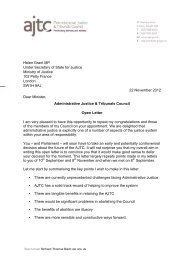Tribunal Justice â A new start - Administrative Justice & Tribunals ...
Tribunal Justice â A new start - Administrative Justice & Tribunals ...
Tribunal Justice â A new start - Administrative Justice & Tribunals ...
Create successful ePaper yourself
Turn your PDF publications into a flip-book with our unique Google optimized e-Paper software.
<strong>Tribunal</strong> <strong>Justice</strong> – A <strong>new</strong> <strong>start</strong><br />
(Lord <strong>Justice</strong> Carnwath – Senior President of <strong>Tribunal</strong>s)<br />
Introduction<br />
1. T-Day has come and gone, without I think any T-5-type disasters. It has been a<br />
remarkable achievement by all involved, not least because, until only three<br />
weeks before, the timetable was still hanging in the balance. I acknowledge<br />
with gratitude the contribution of all those with whom I have been privileged<br />
to work over the last four years.<br />
2. The Times headline on 3 rd November put it rather dramatically “<strong>Tribunal</strong><br />
service reform to create 2,700 <strong>new</strong> judges”. It was not quite what I had said at<br />
the interview. But it did make the crucial point that tribunal judges and<br />
members will from now on be full members of the judicial family. As a further<br />
mark of that we began the process of swearing in the first members of the<br />
Upper <strong>Tribunal</strong>. I was particularly pleased that the Lord Chief <strong>Justice</strong> was able<br />
to attend, and to sit beside me while the oaths were taken. That symbolised the<br />
close links which he is as keen as I am to foster between the courts and<br />
tribunal systems. I am afraid I cannot promise he will be attending the<br />
swearing-in ceremonies that we will be arranging over the coming months (the<br />
logistics of which are a little frightening), but I have no doubt that he will be<br />
there in spirit.<br />
3. As you know, T-Day was the culmination of a process which <strong>start</strong>ed with the<br />
publication in 2001 of review of the tribunal system by Sir Andrew Leggatt, a<br />
former Lord <strong>Justice</strong>. I was reminded last week by Lord Irvine of the vital role<br />
he played in <strong>start</strong>ing the project, and getting the government committed to it.<br />
4. The Leggatt vision was to achieve:<br />
“... a system that is independent, coherent, professional, costeffective<br />
and user-friendly… a service fit for the users for<br />
whom they were intended.” 1<br />
He hoped that tribunals would acquire –
“... a collective standing to match that of the Court System and<br />
a collective power to fulfil the needs of users in the way that<br />
was originally intended.” 2<br />
5. The structural changes needed for the creation of the <strong>new</strong> system have now<br />
been largely achieved: the administrative side in April 2006 with the<br />
establishment of the <strong>Tribunal</strong> Service, and now the judicial side. On 3 rd<br />
November 2008 (T-day) the First-tier and Upper <strong>Tribunal</strong>s came into being.<br />
Over the coming months we will be joined by a number of other jurisdictions<br />
in further chambers at each level. The next important milestone will be 1 st<br />
April 2009, when we will welcome the Lands <strong>Tribunal</strong> and the tax and duties<br />
jurisdictions of the Special and General Commissioners and the VAT<br />
<strong>Tribunal</strong>, as part of the largest reform of the tax appeal system for many<br />
decades. The progress on the judicial side is described in my First and Second<br />
Implementation Reviews, available on the website.<br />
6. This project will I believe come to be seen as a textbook example of what can<br />
be achieved by judges and administrators working in partnership, with clear<br />
policy objectives and consistent support from Government. But this is only the<br />
beginning. We will now have the tools and system to enable us to plan<br />
together to provide a better service to our users in practical ways. The<br />
structural changes are no more than a means to this end.<br />
What is tribunal justice, and how will it develop?<br />
7. Fifty years have passed since the Franks report 3 confirmed the modern status<br />
of tribunals in the UK as part of the judicial system. Yet, it is only recently<br />
that the courts have begun to pay much attention to the special features of<br />
tribunals, as distinct from the courts.<br />
8. The influence of Baroness Hale (a former member of the Council of<br />
<strong>Tribunal</strong>s) has been much in evidence. In a Scottish case in 2006, 4 she spoke<br />
of the transition of tribunals from being objects of “the deepest of suspicion”<br />
to their acknowledged role as “an essential part of our justice system“. She<br />
referred to the advantages of tribunals identified by Franks:<br />
“… cheapness, accessibility, freedom from technicality,<br />
expedition and expert knowledge of their particular subject.” 5<br />
9. She highlighted some “facts of tribunal life”, for example -<br />
i) “the great advantage, both to its users and to its decision-making, of<br />
being able to call upon the people with the greatest expertise in the<br />
subject matter of the claim”;
ii)<br />
the objectivity of the system: “the system is there to ensure, so far as it<br />
can, that everyone receives what they are entitled to, neither more nor<br />
less”; and<br />
iii)<br />
the special role of the chairman: “It is also a fact of tribunal life that<br />
they are presided over by lawyers whose role is not only to conduct the<br />
hearing in a fair and user-friendly fashion, to understand the relevant<br />
law, and to explain it to their colleagues. It is also to assist those<br />
colleagues to address the relevant issues in a reasonable and fairminded<br />
way and then write the reasons for their decision.” 6<br />
10. However, when talking about tribunals, generalisations are difficult. <strong>Tribunal</strong>s<br />
vary greatly in the complexity of the cases before them, their financial<br />
significance, and the degree of procedural formality appropriate to them.<br />
Gillies was concerned with the role of the medical member of a social security<br />
tribunal in assessing disability benefit. In such cases, no doubt, cheapness,<br />
accessibility and freedom from technicality are desirable and achievable<br />
objectives. But there is no obvious parallel with, for example, a major case<br />
before the Special Commissioners of Tax or the Lands <strong>Tribunal</strong>. The sums<br />
there involved may be as great as in any case in the High Court, and the legal<br />
and factual issues equally complex. A degree of procedural formality is<br />
unavoidable if justice is to be done, and the specialist expertise of the tribunal<br />
is unlikely to be an adequate substitute for expert representation of the parties.<br />
There may be little in reality to distinguish such a “tribunal” case from a case<br />
before a specialist “court”, such as the Technology and Construction Court.<br />
11. So what are or should be the distinctive features of tribunal justice? What is<br />
the common theme linking these very different types of litigation?<br />
12. A key provision is section 2 of the TCEA, which can be seen as defining the<br />
distinctive characteristics of tribunals. Under it the Senior President is required<br />
in exercising his functions to have regard to the need for tribunals to be<br />
accessible, for proceedings to be handled quickly and efficiently, for members<br />
to be “experts in the subject-matter of, or the law to be applied in, cases in<br />
which they decide matters”, 7 and to the need to develop “innovative methods<br />
of resolving disputes” of the type that come before tribunals”. 8<br />
13. So accessibility, efficiency and expertise are key-notes. The expertise is not<br />
just of specialist lawyers, but of other professionals or experts who have<br />
particular skills or experience in the relevant field. Efficiency connotes the<br />
ability to mould the procedures to suit the particular type of dispute and the<br />
particular client group, to set ourselves realistic targets for reaching fair<br />
decisions quickly and economically, and to meet those targets. Accessibility<br />
means making those procedures understandable and available in a practical<br />
way to all who need them.
Vertical integration<br />
14. What about innovation? The Government White Paper in July 2004 9 gave a<br />
lead. The unified tribunals system would -<br />
“… become a <strong>new</strong> type of organisation, not just a federation of<br />
existing tribunals. It will have a straightforward mission: to<br />
resolve disputes in the best way possible and to stimulate<br />
improved decision-making so that disputes do not happen as a<br />
result of poor decision making.” 10<br />
15. The idea that tribunals are concerned with more than simply refereeing<br />
adversarial disputes between citizen and state is not a <strong>new</strong> one. As long ago as<br />
1958 Diplock J emphasised the inquisitorial role of social security tribunals: 11<br />
“A claim by an insured person to benefit under the Act is not<br />
truly analogous to a lis inter partes. A claim to benefit …<br />
requires investigation to determine whether any, and if so, what<br />
amount of benefit is payable out of the fund. In such an<br />
investigation, the Minister or the insurance officer is not a party<br />
adverse to the claimant. If analogy be sought in the other<br />
branches of the law, it is to be found in the inquest rather than<br />
in an action.”<br />
16. More recently Lady Hale picked up the same point, noting that the process of<br />
benefits adjudication is “a co-operative process of investigation in which both<br />
the claimant and the department play their part.” 12<br />
17. Underlying all these statements there is a broader concept, what I would call<br />
“vertical integration” – the idea that tribunals are just one stage in a<br />
hierarchical process designed in the public interest to achieve fairness and<br />
finality for the citizen in the most efficient way possible. This process <strong>start</strong>s<br />
with the original decision-maker, and includes not just tribunals, but public<br />
and private advice agencies, ombudsmen, mediators and the courts. The same<br />
broader concept was also reflected in the White Paper’s vision for the <strong>new</strong><br />
<strong>Administrative</strong> <strong>Justice</strong> and <strong>Tribunal</strong>s Council, as “an advisory body for the<br />
whole administrative justice sector”, concerned to ensure that “the<br />
relationships between the courts, tribunals, ombudsmen and other ADR routes<br />
satisfactorily reflect the needs of users”. 13<br />
18. The citizen’s engagement with these various agencies should be a logical<br />
progression with clear access routes and signposts along the way. It should not<br />
be a game of snakes and ladders.<br />
19. The framework provided by the Act, and the emphasis on innovation, will lead<br />
to more attention being given to extra-judicial means of dispute resolution.
That is already happening. There is a lively debate about the role of internal<br />
review within departments, the use of mediation, and a more flexible<br />
relationship between courts and ombudsmen. I expect that within the<br />
foreseeable future we will take it for granted that these different methods and<br />
agencies are parts of an integrated system, contributing to a single goal: the<br />
fair, efficient and economical resolution of differences in the administrative<br />
field.<br />
20. In what follows I want to focus on two aspects of this broader approach: in<br />
one direction, feedback to decision-makers; in the other, the role of the Upper<br />
<strong>Tribunal</strong> and the higher courts.<br />
Feedback<br />
21. Ideally the process should <strong>start</strong> and finish within the department responsible.<br />
The initial decision needs be made, or action taken, on the basis of the fullest<br />
appreciation of the facts and the law. If not, internal review procedures may<br />
bridge the gap. <strong>Tribunal</strong>s can help to improve the internal decision-making by<br />
constructive feedback from the cases before them.<br />
22. The President of the Social Security <strong>Tribunal</strong>s has for some years submitted a<br />
statutory report to Ministers on the quality of decisions. Section 43 of the<br />
TCEA envisages that practice being continued, and extended to other<br />
jurisdictions. But feedback is one thing. Learning from it and putting the<br />
lessons into practice are quite another. The decision-making Departments need<br />
to accept that challenge. Successive reports have shown how much more could<br />
and should have been done by more effective internal review processes.<br />
23. The previous President expressed some frustration in 2004-5 report<br />
“The areas for improvement should form part of a strategic plan<br />
for improvement informed by the sources of feedback currently<br />
provided and implemented and monitored by the Agencies<br />
operationally with time limits on improvements. There seems<br />
little point in my colleagues and I providing more feedback or<br />
the Department commissioning further studies from the<br />
Appeals Service or their own Standards Committee when no<br />
discernible improvement in decision-making is the result.”<br />
24. In the most recent (and last) report as President of the former tribunal, Robert<br />
Martin repeated this concern. He has set in train discussions with the<br />
Department a view to improving the effectiveness of feedback, and shifting
the emphasis from generalised comment to “feedback that is focussed and of<br />
practical use.” 1<br />
25. I hope to use my position as Senior President, with the help of the Chamber<br />
Presidents, to build on this experience, and extend it across the system more<br />
generally. Two years ago I asked Martin Partington to report on this subject, in<br />
the light of a full review of existing practices and research material. His<br />
illuminating paper is available on the AJTC website. 2 I know there are<br />
sensitivities about the extent to which we, as independent judges, should<br />
engage directly with decision-makers without jeopardising our independence.<br />
Martin Partington comments:<br />
“This argument can be overstated. No one suggests that the<br />
provision of feedback should be about individual decisions in<br />
individual cases. The emphasis must always be on general<br />
problems, for example how evidence is collected in particular<br />
types of case, or general procedural questions.”<br />
26. Personally I am not unduly worried by this issue. I see no difficulty with<br />
exchanges between judges and decision-makers, and indeed representatives of<br />
user groups generally, for example by judges speaking at training conferences<br />
or seminars. What matters is that it is done openly and responsibly. The<br />
involvement of the AJTC may help to mitigate any perception of loss of<br />
independence.<br />
Guidance<br />
27. In any event, there are other more traditional ways in which we can assist the<br />
decision makers. The 2004 White Paper envisaged that it would be an<br />
important part of the Upper <strong>Tribunal</strong>’s role to provide guidance with a view to<br />
achieving consistency across the tribunal system. 14 The role of specialist<br />
appellate tribunals in selecting appropriate cases in which to give general<br />
guidance for the lower tribunals is already well-established. 15 The reform of<br />
the tribunal system, and the establishment of the Upper <strong>Tribunal</strong>, will provide<br />
opportunities to develop the guidance role across the whole tribunal system.<br />
28. This is not only of importance in guiding the tribunals themselves. It should<br />
also help to provide a framework for early resolution of disputes without<br />
recourse to formal procedures. As Trevor Buck has observed:<br />
“When it is delivered, (the tribunal reform) is set to further<br />
push the centre of gravity of administrative justice from the<br />
generation of formal legal disputes towards an expanded sphere<br />
of early intervention, alternative dispute resolution (ADR) and<br />
1 http://www.appeals-service.gov.uk/Documents/SSCSA_PresRep07_08FINAL.pdf<br />
2 http://www.ajtc.gov.uk/docs/Feedbackissuespaper.pdf
settlement. If that vision is delivered there will be an even<br />
stronger case to establish a more efficient and accountable<br />
system of precedent, in order that the earlier exit points in<br />
dispute resolution are negotiated against the backdrop of a<br />
well-defined ‘shadow’ of law.”16<br />
The Upper <strong>Tribunal</strong> and the Higher Courts<br />
29. The establishment of the Upper <strong>Tribunal</strong> is a major innovation. It provides an<br />
unprecedented opportunity to work towards a more coherent and distinctive<br />
system of tribunal justice, drawing together the strands of the principles<br />
developed for the various jurisdictions. This was one of the key<br />
recommendations of the Leggatt report. He described the current system of<br />
appeal routes as “haphazard, having developed alongside the unstructured<br />
growth of the tribunals themselves”. 17 He envisaged that it would be the<br />
function of the <strong>new</strong> appellate tribunal –<br />
“…to develop, by its general expertise and the selective<br />
identification of binding precedents, a coherent approach to the<br />
law.” 18<br />
30. The Upper <strong>Tribunal</strong> will be a “superior court of record”, 19 presided over by<br />
the Senior President. It will be based in London, but will sit at other main<br />
centres when required. 3 The standard model is for the appeal to be on point of<br />
law only, 20 and subject to permission. Where an error of law is found the<br />
Upper <strong>Tribunal</strong> has all the necessary powers to substitute its own decision on<br />
the merits, and to make findings of fact. 21 The TCEA also provides for the<br />
Upper <strong>Tribunal</strong> to have powers of judicial review, in cases transferred (by<br />
category or on a case-by case basis) from the High Court in accordance with<br />
arrangements to be agreed with the Lord Chief <strong>Justice</strong>. It follows that, on<br />
matters within its jurisdiction, the powers of the Upper <strong>Tribunal</strong> will be at<br />
least as extensive as those of the <strong>Administrative</strong> Court.<br />
31. The <strong>new</strong> “<strong>Administrative</strong> Appeals Chamber” will in due course become the<br />
principal agency for appeals on law or judicial review of decisions for<br />
administrative tribunals. For example decisions of the Mental Health Appeal<br />
<strong>Tribunal</strong>s, formerly challengeable by judicial review in the <strong>Administrative</strong><br />
Court, will now be subject to appeal to the Upper <strong>Tribunal</strong>. For this work it<br />
will have the advantage of being able to combine the skills of High Court<br />
judges with the specialist expertise and experience of judges and other experts<br />
who practice regularly in the field. I see us developing a practical partnership<br />
in which we can relieve the <strong>Administrative</strong> Court of some of its burden in<br />
relation to specialist tribunals, and thus help it to concentrate on its central role<br />
as guardian of constitutional rights.<br />
3 See the Second Implementation Review for a description of the proposed procedures.
32. However, this is only the beginning. The purpose is not simply to replicate the<br />
function of the <strong>Administrative</strong> Court, under a different guise. Implicit in the<br />
TCEA is the proposition that conferring these powers on a <strong>new</strong> dedicated<br />
judicial institution will bring benefits that the <strong>Administrative</strong> Court cannot<br />
give. The legislature has thus recognised the advantages, particularly in<br />
relation to complex welfare or regulatory schemes, of supervision by judges<br />
who are specialists in the particular law and practice under review.<br />
33. In this respect the Act is a logical development of a trend which has been<br />
evident in recent cases in the courts. Hale LJ (as she then was) sowed the<br />
seeds of the <strong>new</strong> approach in the Court of Appeal, in Cooke v Secretary of<br />
State. 22 That concerned the circumstances in which permission should be<br />
granted to appeal from decisions of the Social Security Commissioners to the<br />
Court of Appeal. She advocated a cautious approach, with respect to the<br />
Commissioners’ greater familiarity with the “complex legislation”:<br />
“The commissioners will know how that particular issue fits<br />
into the broader picture of social security principles as a whole.<br />
They will be less likely to introduce distortion into those<br />
principles. They will be better placed, where it is appropriate,<br />
to apply those principles in a purposive construction of the<br />
legislation in question. They will also know the realities of<br />
tribunal life. All this should be taken into account by an<br />
appellate court when considering whether an appeal will have a<br />
real prospect of success.”<br />
She referred to social security law as “highly specialised” and “rarely<br />
encountered in practice” by most lawyers. The link of an appeal to the<br />
ordinary courts was important to maintain “fidelity to the relevant general<br />
principles of law”, but the courts should approach their task with “an<br />
appropriate degree of caution”. 23<br />
34. This passage is striking, and potentially controversial, in its apparently upsidedown<br />
approach to the relationship between courts and tribunals. Traditionally,<br />
questions of law are the province of the courts, which are assumed to be<br />
competent to deal with the whole body of the law, whatever its subjectmatter.<br />
24 Lady Hale is drawing a clear distinction between “general principles<br />
of law”, which are seen as clearly within the competence of the courts, and the<br />
“highly specialised” aspects of the social security scheme, which are “rarely<br />
encountered” by the courts, and on which, it is suggested, the Commissioners<br />
are better qualified, having regard to their understanding of the scheme as a<br />
whole. More recently, Baroness Hale returned to the theme in the House of<br />
Lords, 25 citing the same passage in support of a similarly cautious approach to<br />
decisions of the Asylum and Immigration <strong>Tribunal</strong>. 26<br />
35. With that encouragement at the highest level, it is possible to consider how the<br />
Upper <strong>Tribunal</strong> might develop a role which goes beyond the traditional limits
of judicial review, as practised by the courts. Even if the jurisdiction of the<br />
Upper <strong>Tribunal</strong> is limited to appeals on points of law, there is scope for it to<br />
develop a more extensive supervisory role, which may cross the traditional<br />
boundaries between law and fact as understood in the courts.<br />
36. What of onward appeals? The possibility of appeal to the Court of Appeal and<br />
thence to the <strong>new</strong> Supreme Court will remain, but only with permission.<br />
Appeals to the Court of Appeal will only be allowed for cases of general<br />
importance or in other special circumstances. If the Upper <strong>Tribunal</strong> is doing its<br />
job properly, its decisions should come to be regarded as sufficiently expert<br />
and authoritative for onward appeals to be rare, particularly given the handsoff<br />
approach advocated in recent House of Lords decisions. The establishment<br />
of the <strong>new</strong> Supreme Court, due to open in October 2009, provides an<br />
opportunity to develop this relationship.<br />
Conclusion<br />
37. <strong>Tribunal</strong>s have come to play a central part in the UK civil justice system,<br />
particularly in relation to administrative law. Their principal distinguishing<br />
features, as compared to the courts, are flexibility, specialisation, and<br />
accessibility. The present system is the result of piecemeal and incoherent<br />
development of many decades. The TCEA has provided the statutory<br />
framework for a radical restructuring of the existing tribunal jurisdictions into<br />
a coherent two-tier model. The establishment of the Upper <strong>Tribunal</strong> will bring<br />
procedural advantages, in the welcome rationalisation of the confused and<br />
illogical network of appeal routes which tribunal claimants have to negotiate<br />
under the present law. It will also present an opportunity for the development<br />
of more coherent approach to tribunal justice.<br />
38. Legal problems in tribunals do not often attract much political interest, but<br />
they can affect large numbers of people. They need to be sorted out in a<br />
practical and timely way, with proper understanding of the legal and social<br />
context, and the implications for those trying to administer the law in practice.<br />
I believe that we will develop a flexible and co-operative relationship with<br />
decision-makers and with all the other agencies involved, including<br />
ombudsmen and the upper courts, and the AJTC, so that together we can<br />
provide, in Leggatt’s words, “a service fit for our users”.<br />
RC 19.11.08<br />
1 Ibid para 1<br />
2 Ibid para 8<br />
3 Report of the Franks Committee on <strong>Administrative</strong> <strong>Tribunal</strong>s and Enquiries (Cmnd 218, 1957)<br />
4 Gillies(AP) v Secretary of State [2006] UKHL 2 para 36<br />
5 Franks op cit para 38<br />
6 Gillies (above) paras 40-46<br />
7 TCEA s 2(3)
8 Ibid s 2(3)(d). This reflects the policy of the 2001 White Paper, which called for “a radical approach”<br />
to the traditional role of tribunals: “to re-engineer processes radically so that just solutions can be found<br />
without formal hearings at all.”<br />
9 White Paper . 'Transforming Public Services: Complaints, Redress and <strong>Tribunal</strong>s', July 2004.<br />
10 Ibid para 6.1-4<br />
11 R v Medical Appeal <strong>Tribunal</strong> (North Midland Region) Ex parte Hubble [1958] 2 QB 228 at 240<br />
12 Kerr v Dept for Social Development [2004] 4 AllER 385; [2004] UKHL 23 paras 61-3, per Lady<br />
Hale.<br />
13 Ibid para 11.12<br />
14 White Paper op cit para 7.20<br />
15 See generally Trevor Buck Precedent in <strong>Tribunal</strong>s and the Development of Principles (2006) 25 CJQ<br />
458<br />
16 Trevor Buck op cit p 465<br />
17 Op cit para 6.8 See also Lord <strong>Justice</strong> Woolf A Hotch-Potch of Appeals – the need for a blender Civil<br />
<strong>Justice</strong> Quarterly, Jan 1988 pp 44-52.<br />
18 Op cit para 6.32.He recommended the system of the Social Security Commissioners and IAT of<br />
designating selected cases as binding: para 6.26.<br />
19 The precise legal significance of this expression is not entirely clear: see Halsbury’s Laws 4 th Ed<br />
paras 308-9. Leggatt thought that it meant that the tribunal would escape judicial review (para 6.31),<br />
but thought that it might also have the undesirable effect that all its decisions would be binding (para<br />
6.32). There is high authority for the view that a “superior court of record” is not amenable to judicial<br />
review: In re a Company [1981] AC 374, 384F per Lord Diplock; R v Manchester Crown Court ex p<br />
DPP [1993] 1 WLR 1524, 1528 per Lord Browne-Wilkinson, but the issue was left open recently by<br />
the Court of Appeal in relation to the Special Immigration Appeals Commission (G v Secretary of State<br />
[2005] EWCACiv 265)<br />
20 TCEA s 11. Provision is made for wider appellate powers of existing constituent tribunals (for<br />
example, the Lands <strong>Tribunal</strong>’s appellate jurisdiction in respect of law, fact and valuation practice) to be<br />
preserved where appropriate: s 11(6).<br />
21 TCEA s 12<br />
22 Cooke v Secretary of State for Social Security [2001] EWCA Civ 734, [2002] 3 All ER 279<br />
23 Ibid paras 15-17.<br />
24 See e.g. Edwards v Bairstow [1956] AC 14, in which the House of Lords overturned the decision of<br />
the Special Commissioners on whether a particular activity was “an adventure in the nature of a trade”.<br />
Lord Radcliffe criticised the tendency of the courts to treat such questions as “pure questions of fact”,<br />
so as to exclude review. The reason for the courts’ reluctance to interfere was “not any supposed<br />
advantage in the Commissioners of greater experience in the matters of business or any other matters”,<br />
but rather that “by the system that has been set up the Commissioners are the first tribunal to try an<br />
appeal, and in the interest of the efficient administration of justice their decisions can only be upset on<br />
appeal if they have been positively wrong in law” (p 38).<br />
25 AH (Sudan)v Secretary of State [2007] UKHL 49 para [30]. Although only Lord Hope expressed<br />
specific agreement, there was no dissent from her other colleagues.<br />
26 Similarly, Lord Hoffmann, in Hinchy v Secretary of State [2005] UKHL 16, [2005] 1 WLR 967<br />
paras 29-30, had criticised the Court of Appeal for paying insufficient respect to the expertise of the<br />
Commissioners on the practicalities of the social security system.


